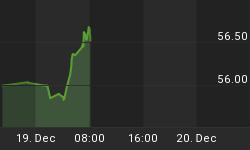
The price of gold, after a short excursion to $ 1,005 in March 2008, started to slide down. One of the main reasons pushing down the gold price, in our opinion, was the massive decline of the oil price. It fell from its high of $ 140/barrel to presently $ 61 und has consequently lost more than 50%.
As a result of this drastic decline and the expected world-wide economic slow-down, the anticipation of a reduced inflation has had a negative consequence.
As share prices world-wide moved into an accelerated general decline culminating in a veritable October crash, the gold price held its ground fairly well and tested successfully various support levels around $ 730 where it is still holding. The next major test level would be around $ 650/670 as a worst case scenario.
We also believe that gold shares are technically and fundamentally absurdly undervalued. In relation to the price of gold, gold and silver shares, as represented by the Gold and Silver Philadelphia Index, have fallen to a twenty-five year low (see chart below).
Such extreme distortions seldom last long.

Once the gold price finds strength from the technical picture, having successfully tested the support levels, we expect fundamental factors to come into play more substantially.
In our opinion, several fundamental arguments should help to push the gold price higher:
-
The enormous deficit in the balance of transactions of the US should weaken the US$ in the medium-term and support the price of gold.
-
The low interest rate level world-wide traditionally favours investments in gold.
-
Risks in the financial system (gigantic indebtedness, collapse of real estate prices in the US), and political turmoil
-
Central banks are expected to reduce gold sales or may have already sold what was earmarked for sale.
-
Mine production is likely to stagnate or will even fall as rising costs and a presently low gold price could lead to closures.
-
Demand from Asian central banks will increase as they tend to diversify out of $-holdings.
-
Private demand for gold from Chinese and Indians should increase with their increasing purchasing power and the desire to increase holdings in the traditional store of value: precious metals
-
Even Europeans rediscover gold as a safe store of value in troubled times and find out that they cannot find the gold coins they want to buy.
Conclusion:
Technical und fundamental reasons speak for a rising gold price and especially for investing in the extremely undervalued gold shares.
Comments on gold shares
There are several method to analyse gold shares:
-
Cash flow per share (CFPS)
The cash flow as a percentage of the share price has dropped to low levels and many companies, especially in the mid-sized and smaller segments, offer excellent opportunities.
-
Net Asset-Premium (Share price less NAV as a percentage of the share price)
How much profit remains after a company has mined the total mineral reserves of a deposit? What kind of premium is the market willing to pay? Such premiums have fallen drastically lately and attractive low percentages in the "mid tier" and "junior" sectors can be found.
While a range for the Net Asset Premium of 70% to 120% are common in "normal" times, this figure in many cases has fallen now to a "discount".
Today the Mid-Tier-Sector sells at a Price/ Net Asset Value of only 0.8 times on average.
In the Junior as well as in the emerging gold producers' sector, there are companies at an extremely depressed ratio of only 0.4 times their Price/ Net Asset Value.
-
Market Capitalisation in relation to liquid assets: Many companies trade below liquid assets
-
Market capitalisation in relation to annually produced ounces: Major companies trade at 6,000 times annual production. Find those which trade at a fraction of 6.000.
-
Market capitalisation in relation to total reserves and resources: Major companies pay at least $ 50 for one ounce of gold in the ground. Find those that trade at less than $ 10.
-
Market capitalisation in relation to expected dividend payout ratio: Dividends is the prove of a successful operation. Find those which are cheap in relation to their payout ratio.
While major gold producers have also suffered major stock price corrections, medium and junior producers have been hit hardest and have put them on an extreme low valuation. These companies promise the biggest gains once the market will turn.
As a consequence, we urge you to buy gold and silver shares now. Do not pick just a few stocks but diversify into at least twenty-five companies or buy a diversified fund specialised in junior stocks like.
Find out which companies we recommend at www.pzim.ch

**************************************************************
Disclosure: The author has not been paid to write this article, nor has he received any other inducement to do so. The author is a shareholder in the company and will benefit from any increase in the company's share price.
Disclaimer: The author's objective in writing this article is to invoke an interest on the part of potential investors in this stock to the point where they are encouraged to conduct their own further diligent research. Neither the information nor the opinions expressed should be construed as a solicitation to buy or sell this stock. Investors are recommended to obtain the advice of a qualified investment advisor before entering into any transactions in the stock.
**************************************************************
 Kurt Hug
Kurt Hug
Manager of
ANTARES STRATEGIC INVESTMENT AG
for
P. ZIHLMANN INVESTMENT MANAGEMENT AG
ANTARES STRATEGIC INVESTMENT AG
Kurt Hug, Manager
Phone +41 43 500 23 90
Email: kurt.hug@antaresinvest.ch















